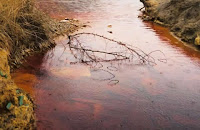
What is water pollution?
Water pollution is the contamination of water bodies.
Water pollution affects plants and organisms living in water bodies causes damage to them, its food cycle and natural biological communities.
Water pollution happens when pollutants are thrown directly or indirectly into water bodies without enough treatment to destroy harmful compounds.
Point source pollution
It is contaminant that goes in a waterway through a pipe or ditch. Examples are discharges from a sewage treatment plant, a factory, or a city storm drain.
Non-point source pollution
It is the diffuse of contamination that does not originate from a single discrete source. It is pollution made of small amounts of contaminants gathered from a big area. Contaminated storm water washed off of parking lots, roads and highways is called urban runoff, which is sometimes included under non-point source pollution. This runoff is channeled into storm drain systems and released through pipes to local surface waters and becomes a point source pollution. But when this contaminated water is not channeled to drains but directly to the ground it becomes a non-point source.
Groundwater pollution
Groundwater pollutions are sometimes called groundwater contamination and is not as easily classified as surface water pollution. A spill of a chemical contaminant on soil which is located away from a water body may not create point source or non-point source pollution, but may contaminate the aquifer below.
Causes of water pollution
The specific contaminants are a wide spectrum of chemicals, pathogens, and physical or sensory changes such as elevated temperature and discoloration. While many of the chemicals and substances that are regulated may be naturally occurring, the concentration is the key in determining what is a natural component of water and a contaminant.
Oxygen-depleting substances may be natural materials, such as plant matter as well as man-made chemicals. Other natural and anthropogenic substances may cause turbidity blocking light, thus disrupting the plant growth and also clogging the gills of fish.
Many of the chemical substances are toxic. Pathogens can produce waterborne diseases in human or animal hosts. Eutrophication is an increase of the concentration of chemical nutrients in an ecosystem to an extent that it increased in the primary productivity. It depends on the degree of eutrophication, if subsequent negative environmental effects like anoxia and severe reduction in the water quality may occur, that affects the aquatic animals and plants.
Taken from:
http://en.wikipedia.org/wiki/Water_pollution

No comments:
Post a Comment